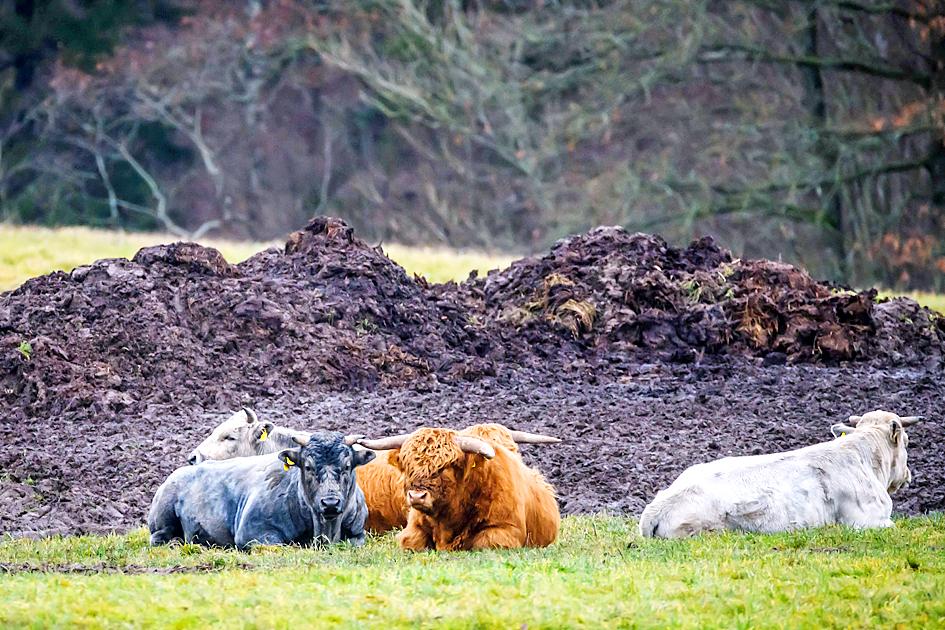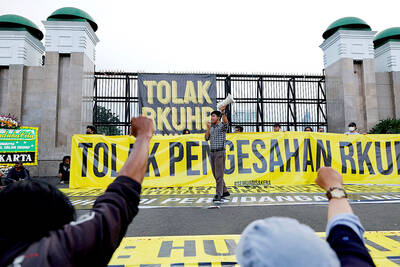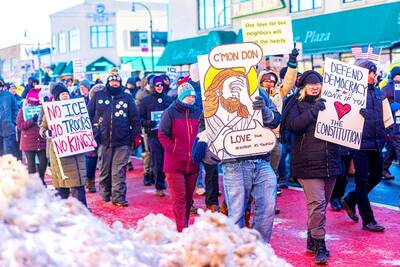Once a rarity, cows with light-blue or dark ultramarine hides might again be glimpsed grazing on the Latvian countryside among the regular brown, black or white spotted cattle.
The unique and hardy breed, driven to near extinction during the Soviet era, has made a comeback over the past few decades as an unlikely symbol of Latvian national identity.
“Their worst days are over,” said Arnis Bergmanis, head of the Ciruli animal park in the village of Kalvene, which serves as a breeding facility for the cattle.

Photo: AFP
“Blue cows are unique and wonderful. I’m glad we can help them thrive,” he told reporters while examining a calf.
In 2000 there were only 18 blue cows in Latvia, but today they number about 1,500 — thoroughbreds as well as hybrids.
Originally found only on the Baltic coast in the Kurzeme region, they are increasingly popular in central areas too.
“We are happy to help every new farmer or guesthouse owner get their own special blue cow,” Bergmanis said.
Rural innkeepers acquire the cattle as a tourist attraction, while farmers include a token blue cow in their herd for its strong maternal instinct.
“If a calf of any color loses its mother or gets separated, the blue cow will take the calf and raise it as its own,” Bergmanis said.
Blue cows lived on the coast, where they led a spartan lifestyle, able to subsist on bush branches and dune grass — fodder considered inedible by other cattle.
Legend has it that they get their color from the sea, although in fact they are born almost beige.
Their coat soon turns blue and gets darker with the years.
The pigment also influences the muscular tissue, producing beef that is exceptionally dark, although their numbers have always been too low for meat sales on a mass scale.
When the communists came to power under the Soviet occupation, they put an emphasis on mass production of beef and dairy. They favored more generic cattle, causing the blue cow to almost go extinct.
However, theater — of all things — saved the day.
Following the highly popular 1970s play The Blue One by Latvian playwright Gunars Priede, the special cattle returned to public consciousness, becoming a symbol of vanishing national identity.
In 2006, farmers, scientists and enthusiasts founded the Blue Cow Association to safeguard the breed.
Meanwhile, the Latvian government offers special subsidies for owners of blue cows.
Blue cows provide less milk than average cattle — about 5,000 liters per cow per year compared with 8,000 for the Holstein breed — but the milk is healthier and more nutritious.
They also stand out for their ability to thrive in harsh conditions, Blue Cow Association head Daiga Simkevica said.
“The strong, independent and robust blue cow can live all year round outdoors, even during the winter frosts, which many other cattle breeds can’t endure,” Simkevica told reporters.
The association organizes seminars for farmers, keeps meticulous records to avoid inbreeding, works to keep the population growing and also does research on the cattle.
“In the future we hope to carry out full DNA analysis to identify those genes that are unique to the blue cow,” Simkevica said. “We’ve never had a blue cow catch the bovine leukemia virus, therefore we hope to identify genes that might benefit all other cows, too.”

Shamans in Peru on Monday gathered for an annual New Year’s ritual where they made predictions for the year to come, including illness for US President Donald Trump and the downfall of Venezuelan President Nicolas Maduro. “The United States should prepare itself because Donald Trump will fall seriously ill,” Juan de Dios Garcia proclaimed as he gathered with other shamans on a beach in southern Lima, dressed in traditional Andean ponchos and headdresses, and sprinkling flowers on the sand. The shamans carried large posters of world leaders, over which they crossed swords and burned incense, some of which they stomped on. In this

Indonesia yesterday began enforcing its newly ratified penal code, replacing a Dutch-era criminal law that had governed the country for more than 80 years and marking a major shift in its legal landscape. Since proclaiming independence in 1945, the Southeast Asian country had continued to operate under a colonial framework widely criticized as outdated and misaligned with Indonesia’s social values. Efforts to revise the code stalled for decades as lawmakers debated how to balance human rights, religious norms and local traditions in the world’s most populous Muslim-majority nation. The 345-page Indonesian Penal Code, known as the KUHP, was passed in 2022. It

‘TRUMP’S LONG GAME’: Minnesota Governor Tim Walz said that while fraud was a serious issue, the US president was politicizing it to defund programs for Minnesotans US President Donald Trump’s administration on Tuesday said it was auditing immigration cases involving US citizens of Somalian origin to detect fraud that could lead to denaturalization, or revocation of citizenship, while also announcing a freeze of childcare funds to Minnesota and demanding an audit of some daycare centers. “Under US law, if an individual procures citizenship on a fraudulent basis, that is grounds for denaturalization,” US Department of Homeland Security Assistant Secretary Tricia McLaughlin said in a statement. Denaturalization cases are rare and can take years. About 11 cases were pursued per year between 1990 and 2017, the Immigrant Legal Resource

ANGER: US-based activists reported protests at 174 locations across the country, with at least 582 arrested and 15 killed, while Khamenei said the protesters were ‘paid’ Iran’s supreme leader on Saturday said that “rioters must be put in their place” after a week of protests that have shaken the Islamic Republic, likely giving security forces a green light to aggressively put down the demonstrations. The first comments by 86-year-old Ayatollah Ali Khamenei come as violence surrounding the demonstrations sparked by Iran’s ailing economy has killed at least 15 people, according to human rights activists. The protests show no sign of stopping and follow US President Donald Trump warning Iran on Friday that if Tehran “violently kills peaceful protesters,” the US “will come to their rescue.” While it remains